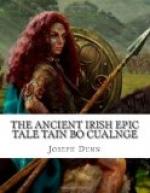The Tain Bo Cualnge is one of the most precious monuments of the world’s literature, both because of the poetic worth it evidences at an early stage of civilization, and for the light it throws on the life of the people among whom it originated and that of their ancestors centuries earlier. It is not less valuable and curious because it shows us the earlier stages of an epic—an epic in the making—which it does better perhaps than any other work in literature. Ireland had at hand all the materials for a great national epic, a wealth of saga-material replete with interesting episodes, picturesque and dramatic incidents and strongly defined personages, yet she never found her Homer, a gifted poet to embrace her entire literary wealth, to piece the disjointed fragments together, smooth the asperities and hand down to posterity the finished epic of the Celtic world, superior, perhaps, to the Iliad or the Odyssey. What has come down to us is “a sort of patchwork epic,” as Prescott called the Ballads of the Cid, a popular epopee in all its native roughness, wild phantasy and extravagance of deed and description as it developed during successive generations. It resembles the frame of some huge ship left unfinished by the builders on the beach and covered with shells and drift from the sea of Celtic tradition. From the historical standpoint, however, and as a picture of the old barbaric Celtic culture, and as a pure expression of elemental passion, it is of more importance to have the genuine tradition as it developed amongst the people, unvarnished by poetic art and uninfluenced by the example of older and alien societies.
According to the Chronicles of Ireland, as formulated in the Annals of Tigernach,[5] who died in 1088, King Conchobar of Ulster began to reign in the year 30 B.C., and he is said to have died of grief at the news that Christ had been crucified. His reign therefore lasted about sixty years. Cuchulain died in the year 39 A.D. in the twenty-seventh year of his age, as we learn from the following entry: “The death of Cuchulain, the bravest hero of the Irish, by Lugaid son of Three Hounds, king of Munster, and by Erc, king of Tara, son of Carbre Niafer, and by the three sons of Calatin of Connacht. Seven years was his age when he assumed arms, seventeen was his age when he followed the Driving of the Kine of Cualnge, but twenty-seven years was his age when he died."[6]
A very different account is given in the manuscript known as H. 3. 17, Trinity College, Dublin, quoted by O’Curry in his Manuscript Materials, page 508. The passage concludes with the statement: “So that the year of the Tain was the fifty-ninth year of Cuchulain’s age, from the night of his birth to the night of his death.” The record first quoted, however, is partly corroborated by the following passage which I translate from the Book of Ballymote, facsimile edition, page 13, col. a, lines 9-21: “In the fourteenth year of the reign




